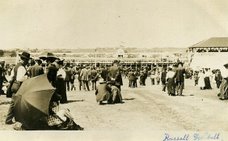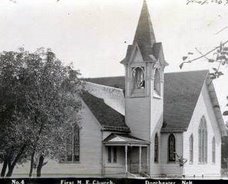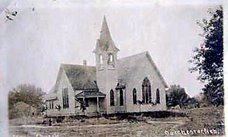Crete quickly rose from the prairie in 1869 and 1870 when the railroad was extended to our area, bringing many settlers. In 1871, two rival towns merged to form a new town, which was named after Crete, Illinois, the former hometown of an early settler. In those early days, Crete was a contender for county seat.
According to Andreas' History of the State of Nebraska, written in 1882, in just a 10- or 12-year span, Crete had been "transformed into a splendid city teeming with a thrifty population, bustling with busy marts of trade, resounding with the measured stroke of industry and manufacture, wherein the sound of the millstone is ever heard and the grinding is never low." Andreas wrote: "The marvel is, not that Crete exists at all, but that in so short a time, it should have attained so much and such splendor."
Here is more on Crete's founding according to Andreas' History:
The first settler to locate on and near the town site was J.C. Bickle, who staked off his place in the summer of 1863. Others, attracted by the beauty and auspices of the place, came in, and soon the valley of the Blue became dotted off, here and there, with the rude habitations of numerous settlers. Those who owned the lands afterward selected as the town site, were Bickle, Mary George, Samuel Bingaman, G.W. Bridges and O.W. Baltzley. The town, or rather two adjacent towns were laid off in the summer of 1870; one by Bickle, on a 40-acre tract lying in the bend of the river, and called Blue River City, and one by the town company of the Burlington & Missouri River Railroad Company, lying just back of and adjacent to the one laid out by Bickle, and named Crete. A rivalry was thus engendered between the two parties as to which should control. The town company, backed by the railroad, had both the capital and influence; but, that Bickle held the commanding site, secure against the world and superior to any along the line between the Mississippi and Platte rivers, was patent to all. The company knew this, and exerted themselves strenuously to obtain possession of the land, which Bickle very independently refused to grant.
To such length the matter ran, in the attempt of the company to freeze Bickle out, which he in turn vehemently met, as with fire against fire, that they gratuitously gave lots to those who would take them. This game foreshadowed no benefit to the company, who, seeing they had clenched holds with the wrong man, resolved to select a better location than they now had, and by the strategems practiced by railroads, to bleed Bickle's town to death. However, before this move was made, a compromise of the matter was effected, and the two places became united into the present town of Crete.
 By the early 1880s, Crete had blossomed into a city of 2,500 inhabitants, with stately business blocks hedging her streets, 50 business houses of varied sorts and sizes, 16 manufacturing establishments, three grain elevators; three large lumber yards, two extensive coal yards, eight physicians, and as many lawyers, and six churches, two banks, the united capital stock amounting to $225,000, a fine opera hall, and three hotels, one of which, the Cosmopolitan, under the proprietorship of H. Code, excels, by far, anything of the kind in the State, outside of the cities of Lincoln and Omaha.
By the early 1880s, Crete had blossomed into a city of 2,500 inhabitants, with stately business blocks hedging her streets, 50 business houses of varied sorts and sizes, 16 manufacturing establishments, three grain elevators; three large lumber yards, two extensive coal yards, eight physicians, and as many lawyers, and six churches, two banks, the united capital stock amounting to $225,000, a fine opera hall, and three hotels, one of which, the Cosmopolitan, under the proprietorship of H. Code, excels, by far, anything of the kind in the State, outside of the cities of Lincoln and Omaha.Aside from its industrial base and booming business sector, Crete had something else that made it a shining star in a new state of the union: Doane College. Andreas wrote, "Long before Nebraska became a state, efforts were put forth which had for their object the founding of Christian schools. At the General Association of Congregational Churches gathered at Omaha June 7, 1872, the Committee on Education made an earnest plea in behalf of a Christian College. The outcome of the action of the Association was Doane College, located at Crete, 75 miles west of the Missouri. A Preparatory Department was at once opened -- September, 1872 -- and in one year the first Freshman class was entered."
 Crete has always been the most populated community in Saline County dating back to the county's founding. Industrial growth, including the expansion of The Crete Mills, nurtured Crete to 3,692 by 1950. Once Alpo and Farmland built large facilities on the edge of town, Crete's population skyrocketed to 4,444 by 1970. Another surge of population growth came in the 1990s and early 2000s, pushing the population to around 7,000 people.
Crete has always been the most populated community in Saline County dating back to the county's founding. Industrial growth, including the expansion of The Crete Mills, nurtured Crete to 3,692 by 1950. Once Alpo and Farmland built large facilities on the edge of town, Crete's population skyrocketed to 4,444 by 1970. Another surge of population growth came in the 1990s and early 2000s, pushing the population to around 7,000 people.You can check out pictures of Crete's early years by visiting the Crete Heritage Society's website.




















































Thanks for the connections regarding Crete. As the railroad built west, the NEW towns were alphabetical. So Dorchester followed "Breks" (now just a siding) and Crete, and preceded Exeter, Fairmont, Grafton, Harvard, Inland, Juniata, Kenesaw, L?, Minden?. You can see that eventually I am just guessing. Time for more research. Why does Friend not fit?
ReplyDeleteBill Skocpol (not really Anonymous)
Friend was added after the time of the railroad going through the county Friend was established avout the same time as Wilber was
Delete